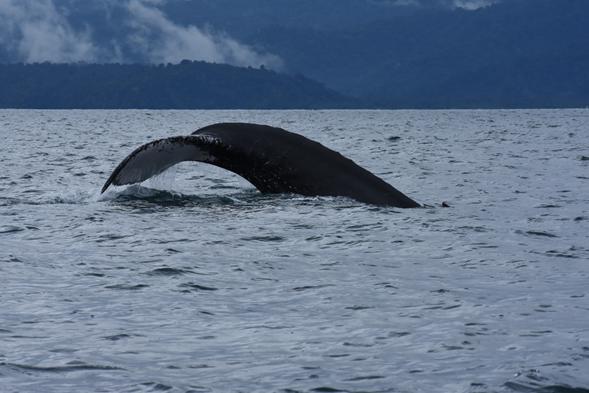Andrea Bonilla Garzón
General goal:
Identify sounds sources in the study areas and to evaluate whether anthropogenic sounds influence the whales’ acoustic behavior.
Objectives:
-Make visual surveys looking for cetaceans in the study areas.
-Obtain acoustic records of HW in Colombian waters and The Antarctic.
-Describe the acoustic landscape identifying sound sources: biologic, natural and anthropogenic in the study areas.
-Identify vocalizations of HW in breeding and feeding areas.
-Establish noise to signal ratio for the HW vocalization.
-Identify noise levels and acoustic threats for HW in the study areas.
-Evaluate human interaction with whales in the study areas.
-Present results to the maritime authorities, Colombian NGO´s and international institutions related with whale’s conservation.

Humpback whale in Bahía Solano. © Andrea Bonilla
Humpback whales (HW) in the Eastern South Pacific migrate each year from high latitudes, where they feed, to low latitudes close to equator, where they breed, forming a management unit called G stock (GS). HW that feed in the Antarctic Peninsula breed in Colombian waters. Historically international effort has studied the biology, ecology, and genetics of this stock. However, there is a lack of information on its dynamics in terms of distribution, movements, structure, acoustical behavior changes, etc., since most of the studies have short-scale study areas. It is necessary to integrate knowledge to understand the dynamic of the whole stock. Consequently, studies with a large spatial scale involving more than one moment of the natural history of the whales are needed. Colombia whale watching is a rapidly expanding activity, and therefore, it is urgent to investigate possible effects of human activities on HW acoustic behavior, such as Interference with reproductive displays, noise levels, etc. knowing their acoustic behavior under different conditions of sound propagation, noise levels and human presence would serve as a point of comparison between locations.
This project focuses on understanding the acoustic landscape where humpback whale (HW) G stock live within a complete migratory year. We conduct visual surveys and use passive acoustics methods. We will evaluate the status of the acoustic landscape of Colombian waters (breeding areas) and the Antarctic (feeding areas); in both, HW live and has different natural and anthropogenic interactions. Our proposed project includes effort close to shore, off-shore, in tropical and polar latitudes. It takes recordings under pristine and low impact- ambient conditions in a feeding area (Antarctica) which is ideal to compare against areas with an increasing human presence delivering anthropogenic noise. Knowledge about the acoustic behavior of humpback whales in feeding areas is poor, and this project offers a good chance to know vocalizations no related to reproductive displays, that implies intra and interspecific interactions.
This project will generate information about 3 National Natural Parks in Colombian and will help to strengthen the commitment of Colombia with the knowledge and conservation of the Antarctic.